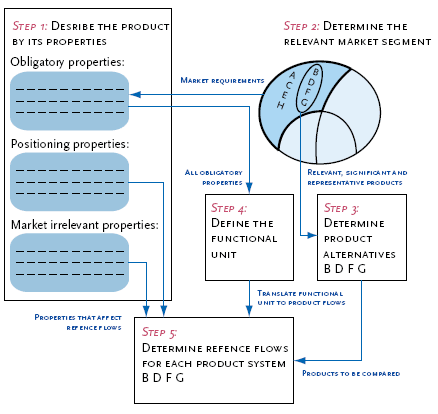|
| Front page | | Contents | | Previous | | Next |
The Product, Functional Unit and Reference Flows in LCA
1 Summary
Subject and purpose
The subject of this guideline is some of the first elements of a life cycle study, typically following immediately after the definition of the goal of the study (see also figure 2), namely:
- the determination of relevant product functions and product alternatives (i.e the object of the study),
- the definition of the functional unit, and the determination of the reference flows.
These elements can often be decisive for the results of a specific life cycle assessment. Therefore, it is important that these elements are performed with diligence.
The purpose of this guideline is to provide an unambiguous procedure for these elements of life cycle assessments.
Three different purposes are served by the mentioned elements:
- To determine the object of study, thereby making a first delimitation of the product systems to be studied. Example: Artificial outdoor-lighting with daylight-spectrum for existing
European fittings.
- To provide a quantified reference unit (the functional unit) for all ot her data in the study. Example: Lighting 10 square metres with 3000 lux for 50000 hours with daylight spectrum at
5600 K.
- To determine the reference flows that provide equivalence between the alternative product systems in a comparative study. Example: 15 day light bulbs of 10000 lumen with a
lifetime of 10000 hours compared to 6 daylight bulbs of 10000 lumen with a lifetime of 25000 hours.
The object of a life cycle assessment is the environmental impacts of a potential product substitution, i.e. the choice of one product instead of another (or the choice of a specific product
instead of refraining from this product).
The functional unit describes and quantifies those properties of the product, which must be present for the studied substitution to take place. These properties (the functionality,
appearance, stability, durability, ease of maintenance etc.) are in turn determined by the requirements in the market in which the product is to be sold.
The reference flows translate the abstract functional unit into specific product flows for each of the compared systems, so that product alternatives are compared on an equivalent basis,
reflecting the actual consequences of the potential product substitution. The reference flows are the starting points for building the necessary models of the product systems.
Based on this, a step-wise procedure is described for these elements of a product life cycle study:
Five-step procedure
The procedure is divided in five steps:
Step 1: Describe the product by its properties.
Step 2: Determine the relevant market segment.
Step 3: Determine the relevant product alternatives.
Step 4: Define and quantify the
functional unit, in terms of the obligatory product properties required by the relevant market segment.
Step 5: Determine the reference flow for each of the product systems.
Table 1 gives an overview of the relations between the three purposes and the five steps in the procedure, and figure 1 gives a graphical summary of the information flow between the
steps.
Table 1.
The three purposes and 5 steps of the procedure
| Purpose |
Steps in procedure |
Described in section |
| I. Determine object of study |
1. Product properties2. Market segment3. Product alternatives |
3.1.13.1.23.1.3 |
| II. Provide quantified reference |
4. Functional unit |
3.2 |
| III.Provide equivalence of product systems |
5. Reference flow |
3.3 |
The entire procedure can be found in a checklist form in section 3.4, especially aimed at the reader who does not need the detailed justifications and examples, e.g. if you have
previously read the guideline and just need to recapitulate the procedure in connection to a practical application.
Figure 1.
Information flow between the five steps in the procedure

Variation of the procedure for different applications
In general, the procedure is independent of the application areas. However, the detailed procedure is mainly relevant for such applications where the compared products differ in
properties (e.g. functionality, appearance, stability, durability, ease of maintenance). When studying a product substitution that involves only products with identical properties, the
procedure may be followed less stringently. The same is true when looking exclusively at one specific product compared to refraining from this product.
Although the procedure is described in five consecutive steps, it should be noted that it may often be relevant to perform the procedure in an iterative or concurrent way: The product
properties described in step 1 may be determined at the same time as, or even from, information on the market segmentation (step 2). The product or the product alternatives (step 3)
may be given in advance, and thus contribute to the definition of the relevant product properties (step 1). And the functional unit can be defined (step 4) without having first determined
the relevant product or the product alternatives (step 3).
If the result of one or more steps in the procedure is questionable or uncertain (and especially if this is the case for the market segmentation of step 2), more scenarios should be applied
to reflect the limited knowledge. The extent of such alternative scenarios depends on the needs of the target group for the study.
| Front page | | Contents | | Previous | | Next | | Top |
Version 1.0 November 2004, © Danish Environmental Protection Agency
|